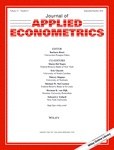
\van Ophem\, H. (2011). The frequency of visiting a doctor: is the decision to go independent of the frequency? Journal of Applied Econometrics, 26(5):872--879.
-
Affiliated authorHans van Ophem
-
Publication year2011
-
JournalJournal of Applied Econometrics
In his analysis of the effects of the reform of the German healthcare system, Winkelmann (Journal of Applied Econometrics 2004; 19: 455-472) investigates the number of doctor visits. He makes a distinction between the decision to go to a physician and the number of times the physician is visited in the observed time period. Winkelmann finds that there is no correlation between both decisions. This result appears to be far from straightforward since the primary driving force in both decisions will be the health of the patient. From this perspective a significant correlation is expected. In this paper, I first replicate part of Winkelmann{\textquoteright}s research. I then set out to analyse whether the zero correlation is actually true or comes from the way the relation between both decisions is modelled. My empirical analysis confirms the latter, but nevertheless also corroborates Winkelmann{\textquoteright}s main conclusions on the relevance of the explanatory variables used in his investigation.